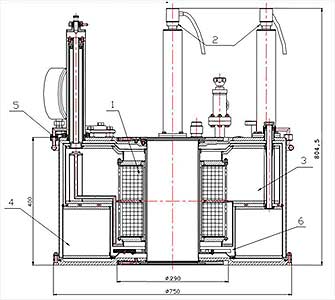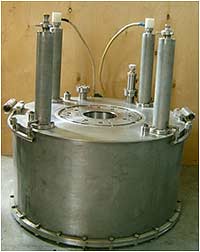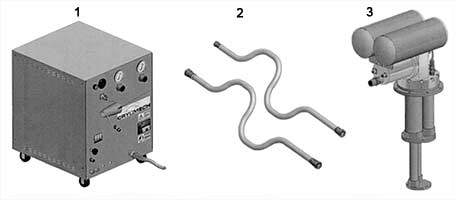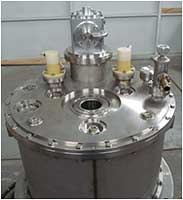





 |
Electromagnets and superconducting magnets
Gyrotrons are made operable by application of magnetic fields of various intensity. For these purposes, GYCOM Ltd. manufactures several types of electromagnets, which differ in the type of cooling of the magnetic coil (solenoid):
|
|||||||||||||||||||||||||||||||||||||||||||||||||
Generation of magnetic fields with higher intensities requires operation of the magnet at high current densities (about 100 A/mm2). At such current densities, only superconducting electromagnetc (cryomagnets) can operate. A “wet” (liquid-containing) cryomagnet is shown in Fig. 3. A coil with a superconducting multi-wire niobium-titanium (NbTi) enameled cable is placed in a tank filled with liquid helium (LHe). In its turn, the helium tank is placed within a nitrogen shield with a nitrogen tank filled with liquid nitrogen (LN). The helium tank and the nitrogen tank with the shield do not contact each other. The temperature of boiling LHe is 4.2°K, and that of boiling LN, 77°K. The NbTi cable goes into the superconducting state at a temperature of 9.2°K. To prevent heat exchange with the atmosphere, the unit is placed in a vacuum cryostat. The special structures for mechanical suspension of the He tank with the solenoid, coolant filling, and injection of the current to the solenlid have low heat conductivity. In the process of operation, “wet” cryomagnets evaporate coolants and require regular refilling with LHe and LN. The filling is performed in order to maintain the level required for submerging of the superconducting coil in the low-temperature medium and maintain the LN temperature of the shield. The coil is cooled additionally at the cost of evaporation of the gaseous helium, which has a temperature close to the boiling point. The evaporating gas removes heat from the current leads and the suspension as well, which reduces heat gain even in non-optimized structures.
Currently, GYCOM has two models of “wet” cryomagnets with the parameters presented in Table 1. Magnets GCM-4 are used for gyrotrons with an operating frequency in the 28 – 105~GHz range, and GCM-6, for the operating frequency in the 105 – 170 GHz.
The most modern and easy-to-operate device is the superconducting liquid-free (“dry”) magnet cooled by a cryorefrigerator, which has an entirely closed working cycle with gaseous high-purity helium. It consists of a compressor (1), which is connected via low- and high-pressure lines (2) with the two-stage expander (3) (see Fig. 4).
Helium is delivered to the expander in the heat exchanger via the high-pressure line. There, in the process of expansion, cold helium removes heat from cryopanels. After that, helium is returned to the compressor via the low-pressure line for further compression and cooling in the compressor. The use of cryorefrigerators requires only an electric power supply system (3-phase mains with a voltage of 380 V at a consumed power of not more than 10 kW) and water cooling (water consumption of 10 l/min).
Operation of high-frequency gyrotrons with magnetic fields exceeding 2.5 T is ensured by using “dry” cryomagnets purchased from the leading manufacturers, JASTEC (Japan) and CRYOMAGNETICS (USA). |
||||||||||||||||||||||||||||||||||||||||||||||||||





